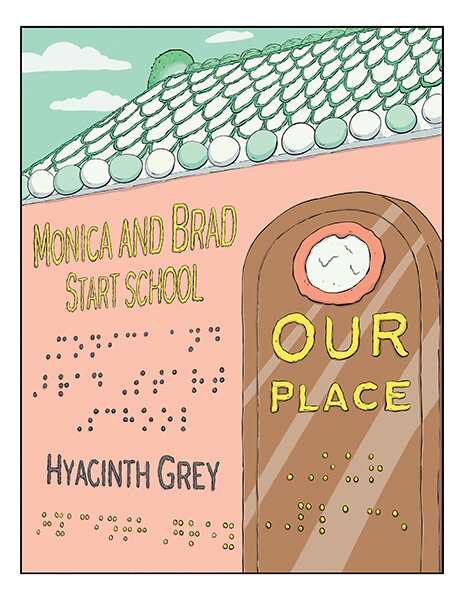Our Place
Monica and Brad Start School
In the sensitive, informative picture book Our Place, blind twins embark on their first day of school.
Written in print and Braille, Hyacinth Grey’s charming picture book Our Place follows the excitement of a first day at school.
Five-year-old twins Monica and Brad are blind. They use their other senses to navigate their world, also relying on the help of other people. Otherwise, they are quite different from one another.
On their first day of school, their mother helps Brad select the clothes he will wear, while Monica chooses her favorite dress by the way the fabric feels to her touch. And despite their fears about going to school, they are encouraged when their parents tell them that a teaching assistant will be there to help them. Loving and firm, the twins’ parents build their confidence and help them to thrive.
At school, Monica and Brad are accepted into their class with ease. They are confident enough to calm and encourage two of their classmates (fellow twins) who are distressed about their parents leaving them. The four children laugh and look forward to playing together, focusing on what they have in common.
But midway into the story, the storytelling shifts in a jarring manner. An omniscient narrator enters to share a detailed explanation of how blind people are able to read by touch, using their fingers to feel groupings of raised dots arranged to form upper- and lowercase letters and numerals. Illustrative tables show the different arrangements of the dots, and a photograph of a Perkins Brailler shows the machine, similar to a typewriter in appearance, that creates them.
After Braille is introduced, Monica and Brad learn it, too. They have varied responses to the difficulties of learning the Braille alphabet, forming words, and doing math problems with Braille numbers: Monica struggles with reading and is frustrated, while Brad has more success; when it comes to numbers and math, it’s Monica who shines while her brother struggles. In this way, the twins are celebrated as individuals with their own preferences, reactions, and emotional responses to stressful situations.
The book’s illustrations are balanced and expressive; the cast’s body language and facial expressions complement the events in the text. Further, the cast is made up of people of different races, ages, and genders, demonstrating equal participation in classroom tasks. A child’s question as to whether Mrs. Perkins’s husband invented the Perkins Brailler reflects lingering gender bias, though.
In the sensitive and informative picture book Our Place, blind twins embark on their first day of school; their story becomes an opportunity to learn about Braille.
Reviewed by
Kristine Morris
Disclosure: This article is not an endorsement, but a review. The publisher of this book provided free copies of the book and paid a small fee to have their book reviewed by a professional reviewer. Foreword Reviews and Clarion Reviews make no guarantee that the publisher will receive a positive review. Foreword Magazine, Inc. is disclosing this in accordance with the Federal Trade Commission’s 16 CFR, Part 255.

